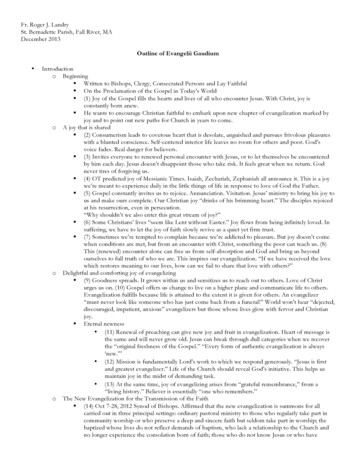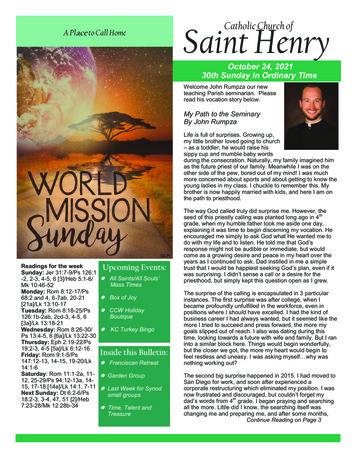
Transcription
The Joy ofSavasanaIf you’ve been to a yoga class you will have certainly practised Śavāsana. It’s a rareclass that does not include the ubiquitous corpse pose to close the practice session.Perhaps your association with the posture is simply a relaxation before you leave theclass, you may look forward to it or you may even have a dislike for the posture (somepeople do but I guarantee everyone can come to love this practice!). But, have youever wondered if there is more to this asana than simply having a rest?This restorative posture is an important part of our yoga practice for manyreasons; firstly, Śavāsana is an asana (yoga posture) the same as any other posture wemay practise during a class. It’s easy for us to think of Śavāsana at the end of a yogapractice as the point at which we switch off but in fact Śavāsana is more of a switchingon, a switching on of our inner light of awareness - it can be the most profound partof our yoga practice. It is the ultimate posture of the yama (observance) of aparigraha(non-grasping) - there is no impressive posture to get into here!16YOGAMAGAZINE.COM
Śavāsana is an opportunity to assimilate all we have practised throughout theclass, to continue the deepening of our awareness once we no longer have to focuson physically moving our body or holding ourselves in a particular shape as requiredby the rest of our physical yoga practise. As an asana the purpose of the physicalpractice of yoga is to align our internal energy (prāna) flow. The physical practice ofasana that has become what we mostly associate with yoga in the west has originswithin the tradition of Tantra, Buddhism and Hatha Yoga. The texts of Hatha Yoga;the Hatha Yoga Pradīpikā probably being the most well-known text nowadays,teach yoga postures as a means of balancing the flow of prāna through the internalchannels called nāḍī (akin to meridians in Chinese medicine) and balancing the innerdirectional flows of the prānic winds (vāyu) to lead us towards the state of integration.Although you may have found yourself in a yoga class to get more bendy, more fit orcalmer, these practices have much more to offer. Śavāsana allows prāna flow to settlewithin the body after stirring the prānic flow through the physical practice of theseyoga postures and even gives us the opportunity to feel that inner energy flow, whichwhen we do is totally absorbing.“As humans we spend so much time being drawn out intothe external but to find balance in our lives and have achance of moving into the state of integration we need tohave periods where we can withdraw.”YOGAMAGAZINE.COM17
“Savasana is a realopportunity to really let goand surrender to yoga”One of the 8 limbs (aṣṭāṅga) of the sage Patañjali describes a practice called pratyahara,which is the withdrawal of the senses. Pratyahara is a means of experiencing a greaterconnection with our deeper layer of self in the present moment. As humans we spendso much time being drawn out into the external but to find balance in our lives and havea chance of moving into the state of integration we need to have periods where we canwithdraw. We don’t have to view this as a shutting out of the external world but more ofa dimming of the lights outside as we turn up the internal lighting. We therefore becomemore awake in our body without a sense of separation from that which appears to be onthe outside but coming into a place of meeting the world from our centre and through ourcentre. To do this we of course have to stay awake in the practice! We should come to thiswonderful practice with an intention of deep alive relaxation that we can enjoy. If we fallasleep we miss the joy of that deep relaxation!18YOGAMAGAZINE.COM
Śavāsana should really be practised for at least 10 minutes to feel the full benefitof the practice. f you find it difficult to stay in Śavāsana for a reasonable length oftime in your own practice, read these simple tips which may help. Having a focuswithin your practice can also help, for example following your breath or scanningyour body (which has its origins in tantric practice of experiencing the macrocosmof the universe in the microcosm of the body) until you are able to fully release intothe practice without the seed of an objective focus. A guided Śavāsana can helpyou to stay with the practice so find one on a meditation app or even ask your yogateacher record one!Remember Śavāsana is a real opportunity to really let go and surrender toyoga. I challenge you to practise Śavāsana for 20 minutes a day for a week and seewhat happens! Even if you don’t have time for a yoga practice before, just practiseŚavāsana. By the end of the 7 days the joyful nature of this wonderful pose will berevealed without a doubt!YOGAMAGAZINE.COM19
Close the door, turn your mobile off, close the curtainsor dim the lights, perhaps cover your eyes (lavendereye pillows can work wonders). You will move into adeeper practice if there is nothing to disturb you.have found that in times when a full letting go is notpossible or I have resistance to being in Śavāsanathat by focussing on a small area of my body that Iam able to release can lead towards further releasesof the body, mind and self. So perhaps feel your feetcompletely relaxing or your belly or any area thatworks for you and see where it leads you. You canconsciously spread out those feeling of release orwarmth from the relaxed area into the rest of yourbody.Be comfortable:Don’t rush it:Support your head with a folded blanket or cushionif needed (your head should not be tilting back at allas it will make you feel spacy). Lengthen the lumbararea of the lower back by lifting and extendingthe pelvis away from the ribcage (don’t tuck yourtailbone under as you want to maintain a naturallumbar curve but do create space in the lumbararea. Feet are around hip width apart - don’t go toowide as this will compress your lower back. Lift yourshoulders and externally rotate the arm so that theshoulder blades deepen into your back ribs anddraw down the back opening your chest as youplace the arms back to the floor. Arms should be alittle way from the body so that there is space in thearmpits and the palms of your hands face upwards.If you are not comfortable with arms away from thebody you may rest your hands on your belly. Thishand position can be comforting, particularly if weare feeling emotionally unsettled. Have a blanket orwarmer clothing if needed (socks are good!) as yourbody temperature will drop. You can place a bolsteror rolled up blanket behind the knees as an option.Pregnant women in 2nd and 3rd trimester shouldpractise lying on their left side with support betweenthe legs and support for the head.To really move into a deep Śavāsana you will almostcertainly need to stay in the posture more than acouple of minutes. It breaks my heart to be in a yogaclass where Śavāsana is almost skipped over withjust a couple of minutes practise at the end. If youare worried you will get carried away with time or fallasleep then set an alarm (there are many meditationapps that have pleasant gong sounds. I’m a fan ofInsight Timer). Śavāsana is a meditative posturewhich takes time to move into.Tips for a joyfulSavasana:Remove distractions:Let go:Don’t drift off. It is not our time to catch up withsome sleep although if you simply can’t stay awakedon’t worry about it but do note that your body istelling you to get more sleep and listen to your body’sinnate intelligence. Focus on your breath to holdyour attention in this space. We can move throughthe final stages of the 8 limbs/aṣṭāṅga of Patañjalifrom pratyahara to dhāraṇā (focus or concentration)to dhyāna (meditation), even towards samādhi(complete absorption).Remember you’re practising yoga:Don’t forget that this pose is still part of your practiceso approach it as you would your asana or meditationpractice as a means of moving towards union orintegration.Namaste - enjoy!WRITTEN BYEasier said than done eh? Looking to letting go inŚavāsana as a complete surrender to the practiceand to the moment doesn’t always come easily. IStay awake!20YOGAMAGAZINE.COMKHADINE MORCOMKHADINE HAS BEEN PRACTISING YOGA FOR OVER 20YEARS. SHE IS A SENIOR YOGA ALLIANCE TEACHERAND SHE CO-RUNS THE 500 HOUR YOGA TEACHERTRAINING PROGRAMME WITH THE VAJRASATISCHOOL OF YOGA IN LONDON AND BRIGHTON. SHETEACHES CLASSES, WORKSHOPS AND RETREATS.FOR MORE INFORMATION, VISIT KHADINEYOGA.COMAND VAJRASATIYOGA.CO.UK/TEACHERTRAINING
by the rest of our physical yoga practise. As an asana the purpose of the physical practice of yoga is to align our internal energy (prāna) flow. The physical practice of asana that has become what we mostly associate with yoga in the west has origins within the tradition of Tantra, Buddhism and Hatha Yoga. The texts of Hatha Yoga;










